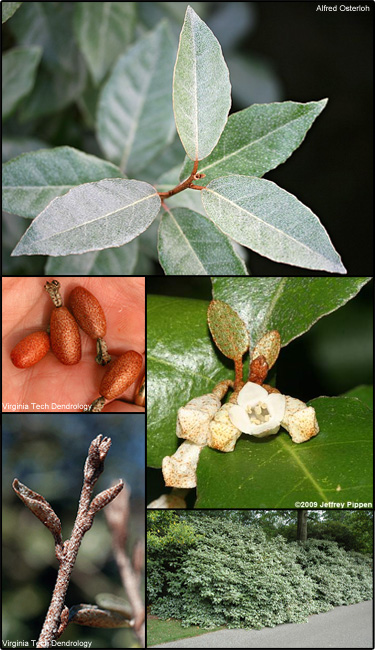Thorny olive (Elaeagnus pungens)
 Description:
Description: Habit: Dense evergreen that is multi-stemmed and short. Grows between 3.3 and 26.3 feet tall and has a thorny appearance.
Leaves: Alternate, lanceolate with entire to wavy margins, upper suface is waxy green and scaly while lower surface is silvery and scaly, 2-4 inches in length and 2 inches wide.
Stems: Reddish brown in color, covered with lenticels when older and smooth when young.
Flowers: 1/2 to 5/8 inches long, pale yellow to white in color, bell shaped with a sweet fragrance. Borne in axillary clusters of 1-3 flowers in the fall.
Fruit and seeds: Drupes, round and red in color with silver scales.
Habitat: Native to Japan and China. Can be found in open areas or shrublands, as well as, open slopes, along roadsides and in thickets.
Reproduction: By seed and vegetative sprouting.
Monitoring and rapid response: Hand removal of all plantings, aggressive tillage and/or mowing when possible (repeat as needed), foliar applications of general use herbicides (imazapyr or glyphosate) with a surfactant. Credits: The information provided in this factsheet was gathered from the University of Florida Center for Aquatic and Invasive Plants and the U.S Forest Service FEIS ELAPUN.
Individual species images that appear with a number in a black box are courtesy of the Bugwood.org network (http://www.invasive.org). Individual photo author credits may not be included due to the small display size of the images and subsequent difficulty of reading the provided text. All other images appear courtesy of Google (http://images.google.com).
Common Name: | Thorny olive |
Scientific Name: | Elaeagnus pungens |
Family: | Elaeagnaceae (Oleaster) |
Duration: | Perennial |
Habit: | Shrubs |
USDA Symbol: | ELPU2 |
